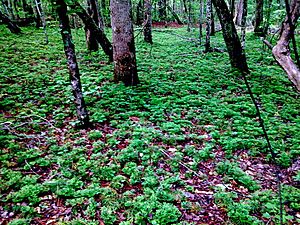Diphasiastrum digitatum facts for kids
Quick facts for kids Diphasiastrum digitatum |
|
|---|---|
 |
|
| Scientific classification | |
| Genus: |
Diphasiastrum
|
| Species: |
digitatum
|
| Synonyms | |
|
|
Diphasiastrum digitatum is a cool plant often called groundcedar or fan clubmoss. It's the most common type of Diphasiastrum found in North America. This plant is a kind of clubmoss, which is a very old group of plants. Clubmosses are different from flowering plants because they don't have flowers or seeds.
This plant gets its common name, groundcedar, because it looks a lot like cedar tree branches lying on the ground. Its leaves are flat and scale-like, just like a grown-up cedar. Plus, it's shiny and stays green all year round! It usually grows about 4 inches (10 cm) tall. The parts that hold its spores stand up a bit higher.
Long ago, people picked a lot of this plant to sell as Christmas decorations. This made its numbers go down a lot. But don't worry, it has grown back well! Now, it often forms big groups that cover the forest floor like a carpet.
Contents
What is Fan Clubmoss?
Diphasiastrum digitatum is a plant that lives for many years. It doesn't have much wood in its stems. These plants usually grow low to the ground, less than 12 inches (30 cm) tall.
Leaves and Branches
Its leaves stay green all year. They are arranged in a spiral, with four leaves spaced evenly. If you look from the side, it seems like there are four columns of leaves. The leaves on the branches are green and shiny. They are scale-like and pointed at the tip.
The branches look like rectangles if you cut them. They are flat on the bottom. The leaves on the sides are the biggest. The leaves on the top surface are flatter and narrower.
Stems and Spores
The stems spread out either above the ground or just under the leaf litter. The parts that stand up have two or more branches near their base. These branches usually grow upwards or spread out. They often look like a small, flat tree or a fan. These upright parts can be 3 to 20 inches tall. However, the parts that don't produce spores are usually less than 8 inches tall.
This plant makes its spores in cone-like structures called strobili. Usually, 2 to 4 strobili grow together at the end of a long stalk. This stalk is called a peduncle.
Where Fan Clubmoss Lives
Diphasiastrum digitatum likes places that are a bit dry or moist. It often grows in forests and open areas with acidic soil. You can find it in the eastern part of North America. This includes parts of Canada, like Ontario and Quebec. It also grows south to Florida and Louisiana in the United States.
Favorite Places to Grow
This plant likes places that are partly shady. It can be found in open forests, thickets, and fields. It usually releases its spores from July to October. Other places it likes are woodlands, bluffs, sandstone cliffs, and old sandy fields. It often grows where oak trees and pine trees are also found.
How Fan Clubmoss is Used
Clubmosses are very old plants. They first appeared about 410 million years ago! People have used Diphasiastrum digitatum in many ways. These uses include medicine, special effects, and decorations.
Traditional Uses
For a long time, people used clubmoss spores and teas made from the leaves. Both Native American and European cultures used them. They used them to help with tummy problems, headaches, and skin issues.
The spores can repel water. Because of this, they were used as a powder for skin rashes. They were even used on baby bottoms! Historically, spores were also used to coat pills. In the Americas and Europe, spores were used to dye fabrics.
Special Effects and More
Clubmoss spores are super flammable! This is because they have a lot of oil in them. Long ago, medicine men would throw the spores into a fire. This would create a bright flash of light for ceremonies.
Because they light up so brightly, spores were used in old flash photography. They were also used in stage shows, fireworks, and even in chemistry labs! Today, people still study if it can help with bladder or kidney problems. But more research is needed to know for sure if it's safe and effective.
Growing Fan Clubmoss
Diphasiastrum digitatum is very hard to grow in a garden. If you try to move a plant, it usually doesn't survive. Growing new plants from spores is very, very slow. It can take about 20 years for a plant to grow from a spore!
It can be grown in special places like greenhouses. There, it needs bright light, lots of moisture, and steady temperatures all year. It also needs weak plant food often. When it's in its early stages, it grows underground. It needs certain fungi in the soil to help it grow. This plant prefers soil that is a bit acidic, sandy, or rocky. It also likes dappled sunlight (light shade) and soil that drains water well.
Plant Name Meaning
The name Diphasiastrum comes from two parts. "Diphasium" is another plant genus. "Astrum" means "incomplete resemblance" or "false." So, Diphasiastrum means "false Diphasium."


